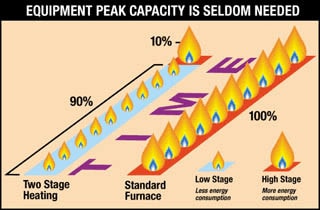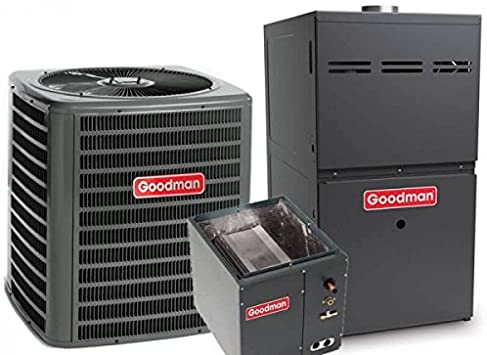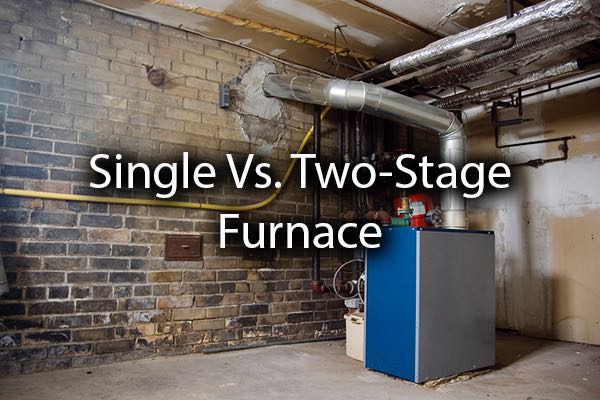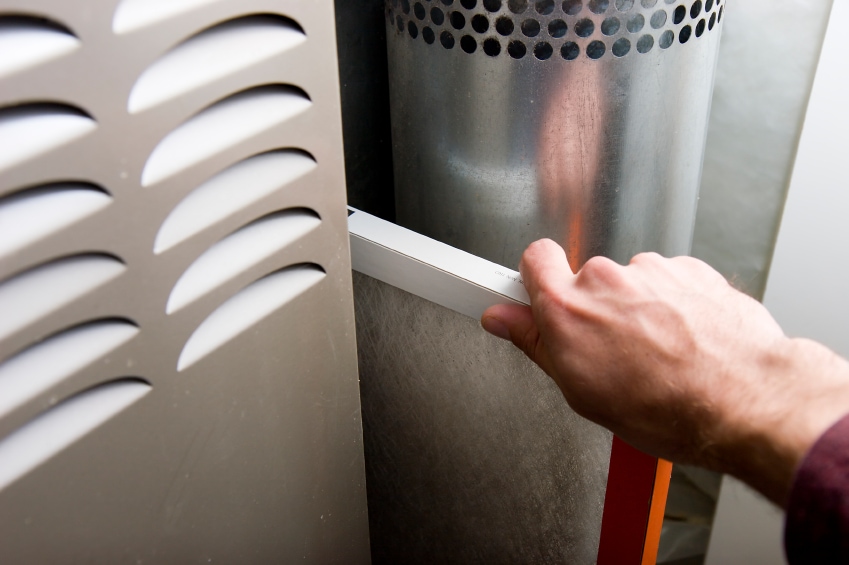Thinking about getting a furnace? There is a big chance that you do not know which one to go for.
Choosing the wrong one can skyrocket your bills, so you need to tread carefully.
This article discusses single-stage and two-stage furnaces so you may have a better idea about which one will suit your needs.
What is a Single Stage Furnace and What is it Used For?
A single-stage furnace is a simple piece of hardware with a gas valve and a blower. The gas valve is either open or shut; there is no in-between phase for it. The blower blows the heated air into the ducting to keep your home warm.
Most single-phase furnaces have a fixed speed blower just like the gas valve. This means the furnace will either work at full capacity or not at all. Once the temperature reaches the thermostat level, the furnace will turn off. Until then, you will hear the loud blower at full speed.
What is a Two-Stage Furnace and How Does a Two-Stage Furnace Work?
A two-stage furnace has two modes when operational: the low- and the high-mode. The gas valve has two stages of operation. It is around 70% open at the low-mode and fully opens on the high.
The furnace will automatically switch to the high mode if the temperature is very low and back to low when it is not that cold. That, coupled with the variable speed blower, can save costs, particularly if your heating costs are off the charts.
The temperature drop with a two-stage furnace is gradual, and the heat is more evenly distributed throughout the place.
Single-Stage vs. Two-Stage Furnace Similarities and Differences
One-stage and two-stage furnaces both heat your home or office, but both offer very different degrees of flexibilities. The valve on the single-stage furnace has only one mode of operation.
A two-stage furnace, conversely, offers you some degree of flexibility. Its valve has two stages, and the blower has variable speed settings.
Single-Stage and Two-Stage Furnace Similarities
Single-stage and two-stage furnaces serve the same purpose. They provide warmth and heat to your home when needed. Both have a gas valve inside of them, and both have an air blower. Let's look more into the similarities:
Gas Burning Mechanism
Both single and two-stage furnaces use a gas valve to input gas, which burns to heat the coil. Both of them have a single valve but can be utilized in different capacities.
Thermostat Input
Even though both furnaces come in different size capacities and shapes, they depend upon the user to set the thermostat. The thermostat can be a single-stage one or a two-stage one.
A two-stage thermostat would add some further functionality. The furnace kicks in if the thermostat temperature is not the same as the ambient one. It keeps the heating process going until the temperature reaches the set thermostat, and then it turns off.
Whether it is the single-stage or the two-stage furnace, the principle remains the same.
Long Life
A furnace is a long-term investment and rightly so. Both types promise a life of more than ten years and usually last much more than that.
Blower
Both furnaces feature an air blower for active heating. The blower blows air through the coil into the connected ducts to start a cycle of warm air blowing through the home.
Single Stage and Two-Stage Furnace Differences
Single-stage and two-stage furnaces might seem the same in functionality, but their way of heating things is different.
The main areas of difference include the function of the gas valve, the blower mechanism, the complexity of the operation, and in some cases, the thermostat. Let's look more into the detail:
Gas Valve Operation
Both single-stage and the two-stage furnace have a single valve; the single-stage valve can either stay open or be shut; there is no in-between. Meanwhile, the two-stage one can operate at two different modes. It can be either 70% open or fully open.
Air Blower
Most single-stage furnaces have a fixed speed blower. On the other hand, the blower on a two-stage furnace has variable rotations per minute.
Operational Complexity
The single-stage furnace is simple when it comes to operational complexity: it is either on or off. When active, it fires at full speed. On the other hand, the two-stage furnace has multiple operation stages. There is a programmable one and a timer-based one. It tries to rectify the temperature on the first stage for as long as possible.
If, after a set point, the temperature is not hot enough, then the second stage kicks in, where it basically becomes the same as a single-stage furnace, i.e., firing at full speed.
So, Which is Better, a One Stage or Two Stage Furnace?
Some people consider the single-stage furnace as obsolete, and contractors recommend that a two-stage one is the requirement of every home these days. That is far from the truth.
Both single-stage and two-stage furnaces have their uses, and sometimes the latter's added cost is impossible to recover over its lifetime.
The single-stage furnace kicks in heats up the home to the desired temperature and then turns off. The two-stage furnace will look for an increase of six to eight degrees per hour; if it can't reach that, then the full power kicks in.
Some two-stage furnaces have this functionality in the shape of a timer. If the desired temperature is not met in, say, ten minutes, then the second burner will start until the desired temperature is reached.
If you are only aiming to maintain your home at a specific temperature, a single-stage furnace is all that you need. There is no need to spend a fortune on the intricate two-stage furnace with this kind of usage.
On the other hand, if you want to adjust the temperature of the home time and again and want different temperatures for the day and night, then a two-stage furnace will save you a lot in running costs.
Single Stage Furnace Pros and Cons
A single-stage furnace employs a simple operational mechanism, but it has its strengths and weaknesses. Let’s have a look at both aspects.
Pros
All single-stage furnaces take advantage of their simple design in a number of ways. These include:
Low Upfront Cost
A single-stage furnace is cheaper to buy than the two-stage option by as much as 25%. This may be because of the simple yet effective design.
Low Maintenance
The single valve and zero complexity make it less prone to breakdowns.
Low Cost of Repair
Although it is highly unlikely, if something does break down, the whole system is very easy to understand and is very easy to repair, owing to the simple design.
Cons
Despite all the benefits, a single-stage furnace has its shortcomings. These include:
No Flexibility
A single-stage furnace cannot adjust to the temperature changes and keeps on churning out heat at a constant speed. This can sometimes heat the room more than what’s required before the furnace shuts off.
Inaccurate Temperature
The ducts and areas close to the single-stage furnace might become hotter than those further away, which might trick the furnace into thinking that the optimal temperature has been reached. This triggers it off. Thus, there can be an unequal distribution of heat throughout the home.
Some areas might become hotter than the others, and some might not be at a suitable warm temperature.
Two-Stage Variable Speed Furnace Pros and Cons
Like the single-stage furnace, the two-stage one has its own positive and negative aspects, as well. Here’s a breakdown:
Pros
The two-stage furnace was a definite improvement in technology that evolved over the years. Its advantages include:
Flexible Operation
The valve in a two-step furnace has a two-step operation. It does not operate at full capacity until required. Moreover, the blower is a variable-speed one and can adjust itself according to the thermostat's needs.
Uniform Heating
The advanced valve and technology inside a two-step furnace allow for a more uniform heating curve, and it can easily bring up the temperature by six to eight degrees each hour. The heat spread is good. The valve is restricted to 70% capacity most of the time. If the furnace doesn’t have to raise the temperature by six to eight degrees an hour, then it operates at 100% capacity to heat quickly.
Low Costs of Operation
The partially open valve means that the cost of heating will not skyrocket. The furnace will only operate at 70% capacity most of the time.

Cons
The two-stage furnace may save you some money in operation costs, but it too comes with its share of shortcomings. These include:
High Costs at full capacity
There is no difference between a single-stage and a two-stage furnace when operating at maximum capacity. The costs will be very much the same if their heat rating and efficiency are the same. The two-stage furnace has a higher upfront cost, and if the use is not that much, it might never pay for its own cost.
Expensive Accessories
A two-stage furnace can work with a single-stage thermostat. But, to take full advantage of the two-stage feature set, a two-stage thermostat is recommended. These can add high costs to the already expensive furnace.
Conclusion
In the end, both single-stage and two-stage furnaces get the job done. If you don’t have extreme climatic changes in your area, then a high-efficiency single-stage furnace would be better.
If you live in a cold region, then a two-stage furnace will go a long way in cutting down costs. Added to that, a high-efficiency unit will pay for itself in under ten years.
People Also Ask
Choosing the right furnace is pivotal in controlling future heating costs. Different furnaces suit different needs. Since there is a large variety on the market, there might be several questions raised in your mind while buying one. Some common ones have been answered for you here:
Does a 2 Stage Furnace Need a 2 Stage Thermostat?
No, a two-stage furnace can work with a single-stage thermostat just as good. It will default back to timing cycles if a two-stage thermostat is not present, but it will work fine. However, if you intend to keep variable temperatures at different times of the day, then you might need a two-stage thermostat.
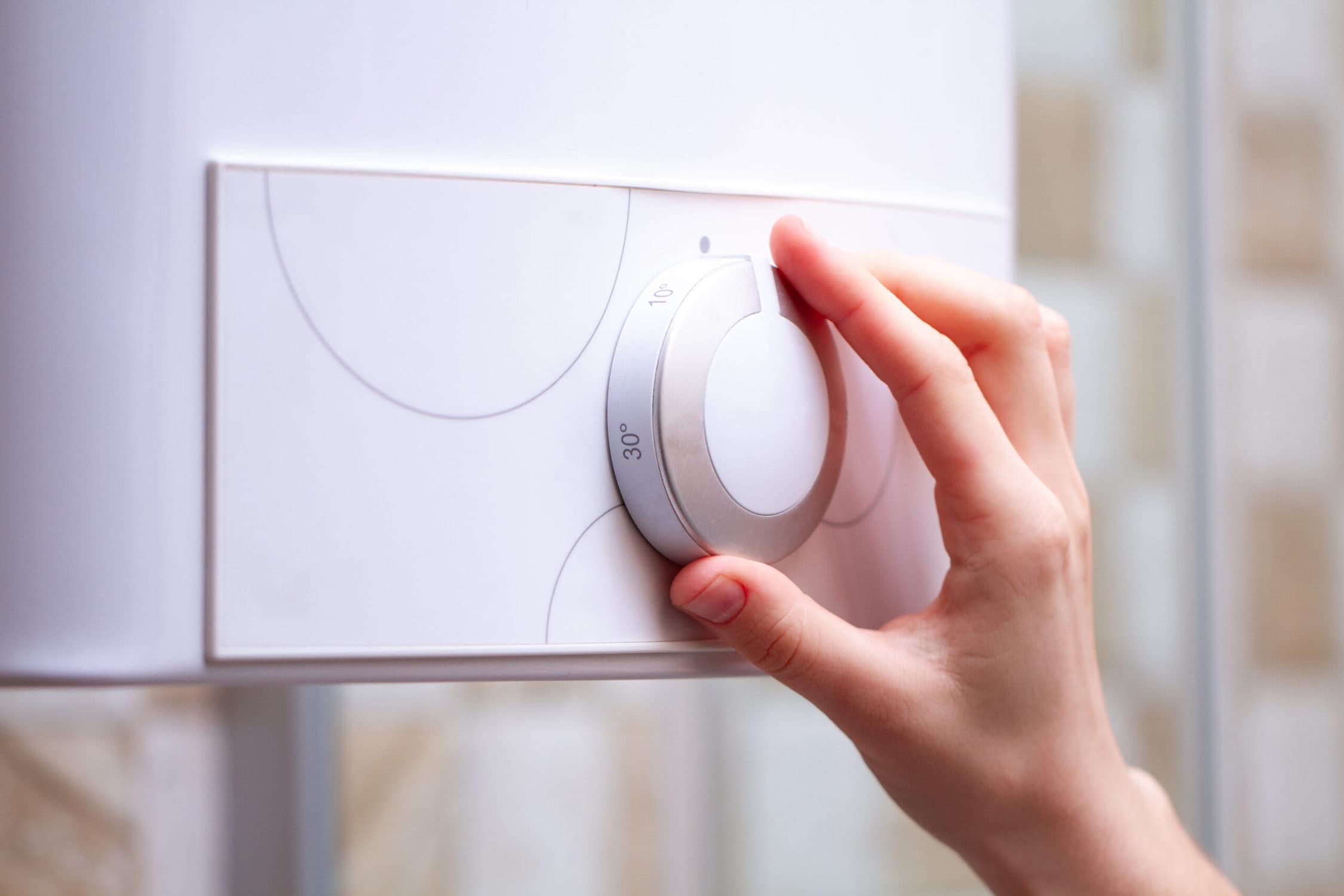
How Do You Wire a 2 Stage Thermostat For a 2 Stage Furnace?
If you want to connect your two-stage furnace to a two-stage thermostat, you can wire it as follows:
- Power-off both heating and cooling systems from the circuit breaker.
- Install a new two-stage thermostat faceplate.
- Map the wires as follows:
- Red maps onto R
- Brown maps onto W2
- Black maps onto C
- Yellow maps onto Y
- Green maps onto G
- White maps onto W
- Red maps onto R
- Add a wire cap for protection.
- Install the thermostat onto the mounting plate.
- Power on the heating and cooling systems.
How Much Does a Two-Stage Furnace Cost?
A two-stage furnace can set you back anything between $1500 and $2500 before factoring in the installation costs. Coupled with the installation costs, it may cost between $2500 and $4000. More expensive and high-end models with superior efficiency can cost as much as $5000 to buy and install.

How Much Does a Single Stage Furnace Cost?
A single-stage furnace costs anything between $1000 and $1500, excluding installation costs. If labor, wiring, and other installation costs are factored in, then the total cost could soar as high as $4000 for high-efficiency models. The price could range between $2000 and $3500 for mid-efficiency ones.
How Much Energy Does a Two-Stage Furnace Save?
If the two-stage furnace sees a huge temperature difference, it'll use the maximum energy and keep working until the desired temperature is reached. Hence, there will be no savings. However, if the temperature increase is between six and eight degrees an hour, then it may only work at 70% operational capacity. This could save up to 30% of costs.
Is a Two-Stage Furnace Worth it?
If the home/office is only somewhat cold, it will not operate at full capacity and hence can save you money. In an area with extreme cold, the furnace will automatically switch to high mode. This switching can save a lot in heating costs, so a two-stage furnace is worth the extra money if your heating costs are off the charts.
What is a Single Stage Furnace Best For?
A single-stage furnace is best suited to the needs of someone who plans to vacate a space soon. If you want to get to a fixed temperature and you do not have multiple story buildings, then a single-stage furnace would be best for you. It will save you upfront costs.
What is a Two-Stage Furnace Best For?
A two-stage furnace comes with an added upfront cost, but it can be worth it if your house is big with multiple heating ducts. It is best suited to maintaining different daytime and nighttime temperatures. Moreover, it distributes heat evenly.
Other Related Content
Here is some other content that might interest you. :



